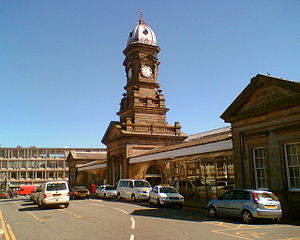
Back محطة قطار سكاربورو Arabic Station Scarborough Dutch Scarborough (stacja kolejowa) Polish Scarborough railway station SIMPLE
 The entrance to the station | |||||
| General information | |||||
| Location | Scarborough, North Yorkshire England | ||||
| Coordinates | 54°16′47″N 0°24′20″W / 54.2798°N 0.4055°W | ||||
| Grid reference | TA039883 | ||||
| Managed by | TransPennine Express | ||||
| Platforms | 5 | ||||
| Other information | |||||
| Station code | SCA | ||||
| Classification | DfT category C1 | ||||
| History | |||||
| Opened | 1845 | ||||
| Passengers | |||||
| 2019/20 | |||||
| 2020/21 | |||||
| 2021/22 | |||||
| 2022/23 | |||||
| 2023/24 | |||||
Listed Building – Grade II | |||||
| Feature | Scarborough railway station | ||||
| Designated | 8 June 1973 | ||||
| Reference no. | 1243452[1] | ||||
| |||||
Scarborough, formerly Scarborough Central, is a Grade II listed[1] railway station serving the seaside town of Scarborough, North Yorkshire. It lies 42 miles (68 km) east of York and is one of the eastern termini on the North TransPennine route; it is managed by TransPennine Express.[2] and is also served by Northern Trains. The station is also at the northern end of the Yorkshire Coast line and is reputed to have the longest station seat in the world at 456-foot (139 m).[3]
From 1907 until 2010, the station approaches were controlled from a 120-lever signal box named Falsgrave; this is sited at the outer end of platform 1 and close to the former excursion station at Scarborough Londesborough Road. In its final years, Falsgrave box controlled a mixture of colour-light and semaphore signals, including a gantry carrying 11 semaphores. The signal box was decommissioned in September 2010 and the gantry was dismantled and removed in October 2010. Its new home is at Grosmont railway station, on the North Yorkshire Moors Railway. The new signalling is a relay-based interlocking with two- and three-aspect LED signals controlled from an extension to the existing panel at nearby Seamer.[4][5] Simplification of the track layout and major renewals took place at the same time.
- ^ a b Historic England. "Scarborough Railway Station (1243452)". National Heritage List for England. Retrieved 6 January 2017.
- ^ "Scarborough (SCA)". National Rail. 2023. Retrieved 3 December 2023.
- ^ "Longest bench gets smart new look". The Scarborough News. 23 March 2003. Archived from the original on 24 April 2019. Retrieved 24 April 2019.
- ^ "Signalling In The Future at Scarborough" (Press release). Network Rail. 18 December 2009. Archived from the original on 29 September 2011. Retrieved 21 December 2009.
- ^ Williams, Alan (December 2010). "Farewell, Falsgrave". Modern Railways. London. pp. 16–17.